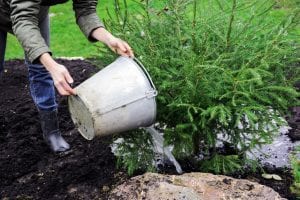Your Guide To Winter Watering Trees & Shrub
Pulling out the garden hose in the winter to water your lawn, trees and plants is probably the last thing you would think of doing in the middle of a cold, blustery day, right? But every spring the arborists at Ryan Lawn and Tree field phone calls related to browning evergreens and declining deciduous plants that were recently planted in the landscape.
While there are many things that can cause this browning, one of the most common problems is a lack of moisture during the winter months. Not enough soil moisture during the winter can cause root injury to all plants as well as desiccation, or extreme drying of the foliage of evergreen plants. With winter on our doorstep, we wanted to offer proper winter watering instructions for trees and shrubs so you can keep your plants healthy all season long.
Why Do My Plants Need Water In The Winter?
During the winter months, it may appear that your trees and shrubs are not doing anything. However, they are just dormant and still require adequate moisture to survive the winter months and produce new growth the following spring. This is very important for evergreen plants that continue to lose moisture through their foliage all winter long. If trees and shrubs are not watered properly in the months leading up to winter and through the winter they can suffer irreversible damage the following spring.
How Much Water Do My Plants Need In The Winter?
We understand that once winter is upon us many homeowners think they are done watering for the year. It is important to understand that this is not the case. The weather in the Midwest has many ups and downs in the winter. The one consistent thread is lack of moisture. In general, trees and shrubs require about 1-2 inches of moisture per month during the dormant season which is generally considering October through March. And don’t be fooled to think a big snowstorm will provide the moisture your trees and shrubs need. On average it takes 13 inches of snow to equal 1 inch of water. Most of us will not see 13 inches of snow for an entire winter season.
When the air and soil temps are above freezing, you should be watering as needed. So pull your garden hose out of the garage or fill up a 5-gallon bucket and water those key plants in your landscapes. You should continue this regimen until the plants in your landscape break dormancy in the spring, usually through March.
What Plants Should I Water In The Winter?
So what exactly are your “key plants” that need to be watered in the winter? In most cases, it is impractical to water every single tree and shrub on your property. If that is the case for you, consider trees and shrubs that would benefit the most from supplemental watering in the winter months. Below is a list of situations and types of plants that should be watered throughout the winter to avoid damage and loses the following spring.
- Newly planted trees and shrubs (5 years or less)
- Evergreen trees and shrubs (established and newly planted)
- Broadleaf evergreens (azalea, euonymus, boxwood, holly etc.)
How To Water Your Trees & Shrubs In The Winter
You may need to get a little creative to get water to your plants during the winter months.
We encourage clients to use a hose and sprinkler on mature plants and large areas of shrubs. If you can use a sprinkler to water, you can measure how much water is applied by using a rain gauge or a small container marked in inches with a pen. Then, when you write down the length of time it takes with your particular sprinkler to put down 1 to 2 inches of water, you’ll know for the future how long you need to water your trees or shrubs.
If you only have a few trees or shrubs to water, we suggest using a 5-gallon bucket. A good rule of thumb is to apply 10 gallons of water for each inch of diameter of the tree trunk measured at 6 inches above ground level.
Since you may only be able to get out and water a few days each month, we recommend you apply a months’ worth of watering all at one time. With our cool weather, there will be less evaporation of the water you applied between waterings.
Consider Specialty Winter Tree & Plant Treatment
If your trees, especially evergreens, don’t seem like they are retaining the moisture you are giving them, you may want to consider an antitranspirant treatment. An arborist can mix and spray an antitranspirant that will protect your trees from moisture loss by slowing the movement of water through the foliage. The spray dries to a transparent coating on your plant without inhibiting its natural grown, osmosis or photosynthesis.
Winter Watering Questions? RYAN Pros Are Here To Help!
If you have questions about watering your trees, shrubs or lawn in the winter, don’t hesitate to reach out to the Ryan Lawn & Tree location nearest you in Kansas City, St. Louis, Wichita, Springfield or Tulsa. Or use our convenient “Ask A RYAN Pro” question form. We have arborists at each location with the knowledge specific to your climate and soil type and offer a free visit to your home to evaluate your plants. We are always happy to guide you on the path of caring for your plants. We look forward to seeing your happy, healthy, hydrated plants in the spring!
Matt Evans has worked as an arborist at Ryan Lawn and Tree for 23 years. Matt has a B.S. degree in horticulture from Kansas State University, is a Board Certified Master Arborist through the International Society of Arboriculture (#MW-3860B) and is a Registered Consulting Arborist through the American Society of Consulting Arborists (#522).










